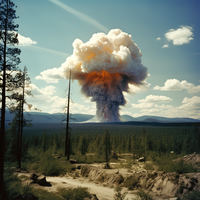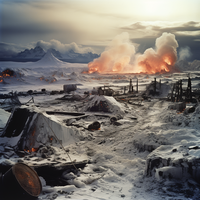History of Hergom
Pre-Wolgos History
For much of its historical narrative, Kupeya remained ensconced within a realm of limited development. Its northern coast extended as a slender belt of temperate land, while the continent itself boasted a penchant for climatic variability that rendered its colder boreal interior inhospitable to pre-industrial societies.
Along this coastal fringe, a string of modest Chalam princedoms emerged over time, forming clusters of villages dependent upon subsistence farming and fishing. These entities occasionally engaged in trade with the warmer Raian archipelago, a connection that punctuated their existence.
Venturing further into the continent's heart revealed hunter-gatherer villages strewn across the landscape, punctuated occasionally by subsistence trading communities settled along the meandering banks of the continent's intricate river networks. The Phula and Alutean peninsula, in contrast, gave rise to societies of greater advancement, characterized by their capacity to erect permanent stone and earth mound temples. Within most of these villages and towns, palisades stood sentinel, and communal grain silos stored the bounty of the subtropical climate, offering these societies an abundance of crops.
Among these regions, Alutea stands as the sole recipient of Ithrien's colonial influence. Trading outposts and coastal holdings established by Ithrienian lords endowed Alutea with a more advanced societal landscape. In exchange for valuable commodities such as cassava, sea products, and even slaves, Alutea engaged in an exchange with Ithrien, elevating its position on the developmental spectrum.
Kupeya occupies a place of profound historical remoteness within the fabric of Gotha, a distinction shared only with central Davai. Its proximity to the southern polar cap shielded Kupeya from the classical hemisphere and its confinement by the dense Raian archipelago to the north have sealed its isolation. This archipelago, once a sprawling realm cloaked in rainforest and coastal cultures trading in spices and tropical treasures, bore witness to piracy and commerce.
Despite its geographic connection to Raia, the region bordering Kupeya has remained veiled in dense, nearly impenetrable rainforests. Consequently, the allure of colonization never extended its grasp here, untouched by the ambitions of both Anarians and Western Davai. Anarians mapped and explored the region but ultimately viewed it as less promising compared to the fertile colonial prospects of Altaia, D’runia, Tzeraka, and the Shangti.
7603 - 7620 - Second Wolgos Trek
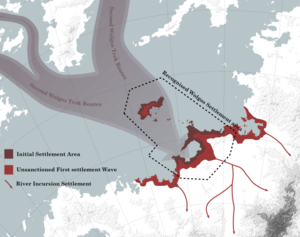

Following the tumultuous aftermath of the Wolgos Scourge, a profound transformation unfolded within Kupeya, catalyzed by what would come to be known as the Second Wolgos Trek. This phase of history witnessed the Peleykros peninsula becoming a converging point for an unparalleled influx of Wolgos migrants, reshaping the region's very fabric.
In the wake of the devastating Wolgos Scourge, the remnants of the once-mighty Bind navy and merchant marine embarked on a grand and audacious endeavor. This involved orchestrating an extensive logistical operation that aimed not only to relocate a vast number of people but also to transport vital machinery and equipment salvaged from the now-ravaged Altaia. To facilitate this ambitious migration, the Bind administration spared no expense, even to the point of financial ruin. They turned to Kamura and others for much-needed assistance, forming a coalition of resources to tackle this Herculean task.
Amid these transformative events, it's crucial to note that the Wolgos migration was not without financial repercussions. The Bind administration, in their determination to orchestrate this ambitious migration, expended significant resources, ultimately leading to their bankruptcy.
The logistical complexity of the migration was staggering, involving the movement of countless Wolgos individuals, often accompanied by their Shriaav allies. Over a span of fifteen years, this massive operation facilitated the transportation of approximately forty million Wolgos and three million Shriaav from Altaia to Kupeya, creating a phenomenon of unprecedented scope.
However, not all Wolgos were prepared to sever their connections with their adopted home. An estimated eight million Wolgos chose to remain in Altaia, displaying a deep attachment to the land despite the challenges that had befallen it. An additional two million Wolgos dispersed across the Shangti region, charting divergent paths amidst this epochal transformation.
For the Wolgos who remained behind, they encountered not only political and economic hurdles but also the weight of anti-Wolgos prejudices as a result of the war they had instigated. Despite these trials, over the following decades, they and their descendants made the decision to migrate to Kupeya, drawn by the promise of new beginnings and opportunities. Nevertheless, even as the majority found their way to Kupeya, over three million Wolgos remain scattered beyond the confines of Hergom.
The initial years in Kupeya were a crucible of trials. Struggles emerged as the Wolgos migrants confronted both the indigenous populations of the region and the scarcity of sustenance. The initial reliance on imported food resources gradually waned, further exacerbating the challenges faced by the newcomers.
As the availability of imports dwindled, the Wolgos community pivoted toward adapting to their new surroundings. The fertile expanse of the Wodranis river plains assumed a central role in this adaptation process. Here, a concerted effort unfolded, marked by the ravenous consumption of native wildlife and the indigenous inhabitants. These resources served as a lifeline, providing sustenance in the midst of change.
This era of transformation also bore witness to the rise of new infrastructural developments. The remaining fragments of the Bind administration moved swiftly to establish a rudimentary construction industry. Fishing ports emerged, along with the construction of docks along the Wodranis and Pleudhara rivers. These pivotal developments not only bolstered the burgeoning settlements but also streamlined the transportation of essential resources, particularly grains and sustenance, back to Ombhrosdhom. This evolving nucleus evolved into a thriving city at the heart of Kupeya's metamorphosis.
7608 Foundation of Hergom ep Swekorwos
7632 - 7634 First Coalition War

Phase one

After three decades marked by reconstruction and ambitious natality policies, both Hergom and the Wolgos had expanded far beyond the original containment zone established following the devastating Wolgos Scourge. Almost yearly, since Hergom's inception, the containment zone had been pushed further through a series of somewhat half-hearted treaty amendments. These amendments were often in response to "rogue" Wolgos settlers venturing beyond the vast and poorly patrolled borders. However, this expansion strategy had its limits, and the nations of Livaria, Kamura, and Ithrien soon grew weary of this unchecked expansion. In response, they established a genuine boundary, jointly patrolled by all three nations, in a concerted effort to halt Wolgos expansion.
For a decade, the Wolgos were effectively contained. Yet, as the world's powers redirected their focus elsewhere, the Wolgos seized the opportunity to amass their strength and meticulously plan their next move. This culminated in the outbreak of the First Coalition War in the spring of 7632. At the time, the Wolgos were still in the process of redeveloping their military industry, and their strength lay more in their sheer numbers than in the sophistication of their equipment. The conflict was predominantly waged with infantry, cavalry, and lightly armored vehicles based on Wolgos civilian truck and automobile designs.
The war erupted on multiple northern fronts, with the breach of the Pelaghr border against the Ithrieni defensive line being particularly swift. The small Ithrieni garrisons, along with poorly equipped Chalam vassals, were quickly overwhelmed, allowing the Wolgos to advance northward. Skirmishes with fragmented Chalam states followed, but their lack of organization made them vulnerable prey for the Wolgos.
In the rugged Lukonos highlands, the Livarian and Kamuran garrisons presented a much more formidable defense, one that remained unbroken during the initial phase of the war. In fact, during this phase, the Livarians and Kamurans even managed to launch the Vatama counteroffensive, which penetrated deep into Hergom's territory before ultimately being pushed back.
The war was characterized by swift-moving, light troops, with the goal of occupying as much territory as possible before reinforcements from the dominant powers of the era could arrive. Ithrien, being the nearest to the conflict, managed to bring reinforcements within five months and established a fortified fallback line at the Lanan Isthmus. Fortunately for Hergom, Ithrien was grappling with second-rate power status, lagging behind most nations in terms of military prowess and defense capabilities. The Ithrieni soldiers fought valiantly for weeks, but over time, the Wolgos breached the Lanan Isthmus line, occupying Alutea and driving the Ithrieni forces off the mainland.
Phase Two
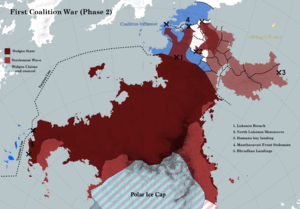
7634 - 7663 Interwar Period
In the aftermath of the tumultuous first coalition, Hergom entered an enigmatic era marked by introspection and silence. While the nation appeared to withdraw from international affairs, beneath this veneer of seclusion, Hergom clandestinely maintained observation cells beyond its borders. Diplomatic overtures were left unanswered, and Hergom remained an enigma for twenty-nine years. Its coastlines, bristling with hostility, deterred any would-be incursions, while the boundary in the Varatran Line became a foreboding line of no return.
During this interwar period, Hergom's interaction with the outside world was largely circumstantial. Instances arose where foreign fishing vessels lost their way or cargo ships found themselves at the mercy of capricious weather, inadvertently straying into Hergom's waters. Tragically, all who ventured too close met swift and brutal destruction. Hergom exhibited a cold indifference, offering no assistance, leading to speculation that they might have exploited these hapless vessels for loot or forced labour.
Hergom's foreign policy during this time was characterized by a steadfast refusal to actively engage with the outside world, except in cases of conflict or territorial expansion. The nation remained resolute in its commitment to strengthen its industrial base and military might, with a vision of cyclically embarking on expansionist campaigns. It is now known that Hergom anticipated the possibility of large-scale offensives roughly once every decade. Wolgos State devised ambitious plans to extend its dominion, with aspirations of encompassing the entirety of Tzeraka and Raia, stretching as far as the Jaladhara River within the next three decades.
Hergom's audacious endeavors to colonize the inhospitable southern polar cap came at great expense. The islands of the Meghes Hweytos in the Antarctic Sea became host to a network of military outposts, initially established for surveying the snow-free mountains and the concealed riches beneath their icy veneer. Over time, these outposts evolved into fishing stations and diamond mining ventures, providing essential resources for their sustenance. The more prosperous outposts burgeoned into small towns, supporting forward military bases. Meanwhile, the southern face of the Hrheghgelon Mountains bore witness to a grim chapter in Hergom's history. Forced labor camps proliferated, extracting nickel and platinum from the unforgiving landscape. Hundreds of thousands of Utura and Chalam laborers perished while toiling to construct the now-infamous Blistered Souls railway, serving the numerous mines in the region.
In Alutea and northern Kupeya, Hergom executed a swift and ruthless campaign of pacification and integration. The populous Gahnam of Alutea, Phula, and Hastos were systematically reorganized into Wolgos-style tribes, and their lands were transformed into nominally autonomous territories. Wolgos settlers arrived in force, and the Gahnam elite were coerced into fragmenting their population into easily controlled and isolated provinces. Razor wire fences sprang up between these provinces, and movement between them was tightly regulated. As Wolgos industry and agricultural enterprises took root, the Gahnam elite were compelled to provide labor for burgeoning agricultural projects. Gradually, these regions transformed into one of Hergom's leading breadbaskets, bearing the indelible marks of their turbulent integration.
7663 - 7664 Second Coalition War
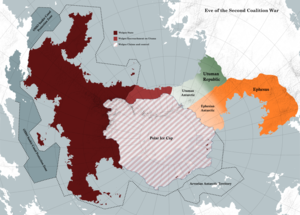
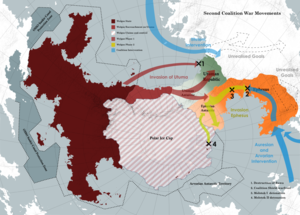
7664 - First use of nuclear weapons in Ephesus Front by the Coalition
